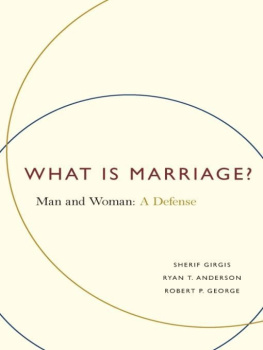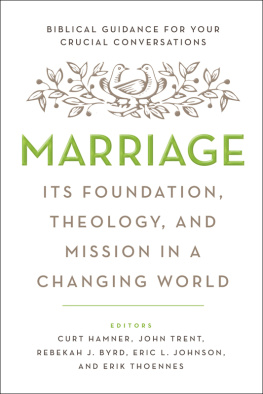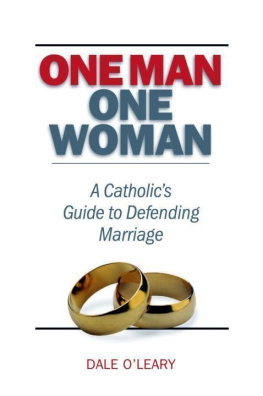Table of Contents
For our parents
A Note on Authorship
This book has been a collaborative project. Sherif Girgis is listed as first author to reflect his primary role in developing our arguments, and in drafting this book and the article on which it expands. Variations of some of the arguments of chapter 2 have been developed over several years by Germain Grisez, John Finnis, Joseph M. Boyle, Jr., Robert P. George, Patrick Lee, Christopher Tollefsen, Gerard Bradley, and Alex Pruss, among others. This book contains refinements in that chapter, and new arguments on related issues in every chapter, made by Girgis as well as by Ryan T. Anderson, who took the lead in shaping the books structure.
MORE INFORMATION
For summaries of our main arguments, and for replies to new questions and criticisms as they arise, please visit www.whatismarriagebook.com.
Acknowledgments
This essay was born as an article before it matured into a book, and it has benefited from extensive help at every stage of its development. Special thanks go to Stefan McDaniel and John Finnis for close readings of the article and book drafts. For valuable comments on one or the other, we also thank Ron Belgau, Maggie Gallagher, Germain Grisez, Patrick Lee, Colin Moran, David Oakley, Matthew OBrien, Nathaniel Peters, Alex Pruss, Nathaniel Schlueter, and Christopher Tollefsen. Their willingness to help was no endorsement of our claims, and we alone bear responsibility for any errors.
We thank the Harvard Journal of Law and Public Policy for editing and publishing What Is Marriage? and for giving us permission to publish this much-expanded version of it. Some material has also been taken from replies to critics that we published in the online journal Public Discourse . Finally, we are grateful to Roger Kimball, Heather Ohle, and the staff of Encounter Books for their confidence in this projects promise, and patience with its progress.
from Epithalamion
Edmund Spenser
And thou, great Juno! which with awful might
The lawes of wedlock still dost patronize;
And the religion of the faith first plight
With sacred rites hast taught to solemnize;
And eeke for comfort often calld art
Of women in their smart;
Eternally bind thou this lovely band,
And all thy blessings unto us impart.
And thou, glad Genius! in whose gentle hand
The bridale bowre and geniall bed remaine,
Without blemish or staine;
And the sweet pleasures of theyr loves delight
With secret ayde doest succour and supply,
Till they bring forth the fruitfull progeny;
Send us the timely fruit of this same night.
And thou, fayre Hebe! and thou, Hymen free!
Grant that it may so be.
Til which we cease your further prayse to sing;
Ne any woods shall answer, nor your Eccho ring.
And ye high heavens, the temple of the gods,
In which a thousand torches flaming bright
Doe burne, that to us wretched earthly clods
In dreadful darknesse lend desird light;
And all ye powers which in the same remayne,
More then we men can fayne!
Poure out your blessing on us plentiously,
And happy influence upon us raine,
That we may raise a large posterity,
Which from the earth, which they may long possesse
With lasting happinesse,
Up to your haughty pallaces may mount;
And, for the guerdon of theyr glorious merit.
May heavenly tabernacles there inherit,
Of blessd Saints for to increase the count.
So let us rest, sweet love, in hope of this,
And cease till then our tymely joyes to sing:
The woods no more us answer, nor our eccho ring!
Song! made in lieu of many ornaments,
With which my love should duly have been dect,
Which cutting off through hasty accidents,
Ye would not stay your dew time to expect,
But promist both to recompens;
Be unto her a goodly ornament,
And for short time an endlesse moniment.
Introduction
TWO VIEWS OF MARRIAGE
What we have come to call the gay marriage debate is not directly about homosexuality, but about marriage. It is not about whom to let marry, but about what marriage is. It is a pivotal stage in a decades-long struggle between two views of the meaning of marriage.
The conjugal view of marriage has long informed the lawalong with the literature, art, philosophy, religion, and social practiceof our civilization (see chapter 3). It is a vision of marriage as a bodily as well as an emotional and spiritual bond, distinguished thus by its comprehensiveness, which is, like all love, effusive : flowing out into the wide sharing of family life and ahead to lifelong fidelity. In marriage, so understood, the world rests its hope and finds ultimate renewal.
A second, revisionist view has informed the marriage policy reforms of the last several decades. It is a vision of marriage as, in essence, a loving emotional bond, one distinguished by its intensitya bond that neednt point beyond the partners, in which fidelity is ultimately subject to ones own desires. In marriage, so understood, partners seek emotional fulfillment, and remain as long as they find it.
In 1595, Edmund Spenser published an ode to Elizabeth Brody on the occasion of their wedding. Epithalamion, meant as an an endless monument to the bride, also gives lasting poetic effect to the beauty, audacity, and reach of the first view of marriage mentioned above.
At the center of Spensers poemand thus central to marriage is the spouses union of body and mind. The bridegroom-speaker devotes four central stanzas to his brides body like a palace fair, then to her inward beauty, to their spiritual union by vows, and then to their bodily union by consummation.
They make their vow complete by making love, which makes new life; thus children give effect to their wishful vow. In this way, their unions fleeting snatches of delight betoken the lasting happiness of a large posterity. Their commitment, like its living fruit, is therefore endless. And for the endless strength to match it, the groom bids Juno, upholder of the laws of wedlock, to bind his marriagebind, not bend, for marriage is a natural bond that society or religion can only solemnize.
Since everyone has a stake in his marriage, the groom calls the whole worldeven the whole cosmosas witness. He calls first on the muses in true Renaissance fashion, and then on the maidens attending to his bride; and on all the village boys, too, running and cheering down the streets. The young men of the town he bids to light bonfires and dance about them, and about them sing. To the nymphs of the Irish rivers he calls, and to the fish that teem within. The woods, the moon, and the sun are his witnesses, and even the heavens, the temple of the gods.
Fast-forward now to the fall of 2006. John Partilla, an Upper West Side advertising executive, meets Carol Anne Riddell, a local news anchor. Like-minded and both brimming with energy, they hit it off; within five years, they are exchanging vows. But when the New York Times gives feature coverage to their wedding, it sparks a blaze of controversy.
Partilla and Riddell were married to others when they metat their childrens pre-kindergarten class. In fact, their families had become friends and even vacationed together. But rather than deny their feelings and live dishonestly, they chose to abandon their spouses and children: All they had were their feelings, which Ms. Riddell described as unconditional and all-encompassing.... It was a gift... but I had to earn it. Were we brave enough to hold hands and jump?








